 RARE ORCHID
RARE ORCHID 
Paphiopedilum rothschildianum

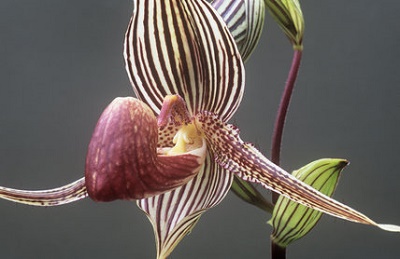
Paphiopedilum rothschildianum, commonly known as the Gold of Kinabalu orchid or Rothschild's slipper orchid, is a large sized clear-leafed species of orchid. It blooms with a tall inflorescence with up to six, large flowers. It is unique in the Corypetalum group by holding its petals almost horizontally, giving the flower a very distinctive appearance. The peak flowering period is from April to May.
Shenzhen Nongke Orchid
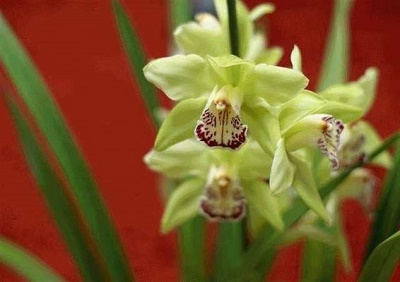
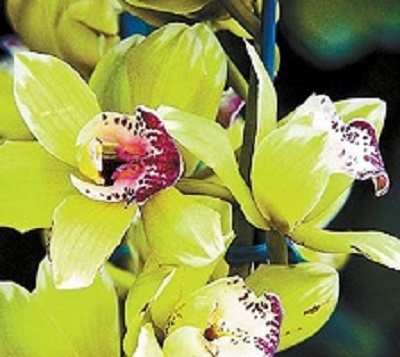
The Orchidaceae are a diverse and widespread family of flowering plants, with blooms that are often colourful and fragrant, commonly known as the orchid family.
Along with the Asteraceae, they are one of the two largest families of flowering plants. The Orchidaceae have about 28,000 currently accepted species, distributed in about 763 genera.The determination of which family is larger is still under debate, because verified data on the members of such enormous families are continually in flux. Regardless, the number of orchid species nearly equals the number of bony fishes and is more than twice the number of bird species, and about four times the number of mammal species.
The family encompasses about 611% of all seed plants. The largest genera are Bulbophyllum (2,000 species), Epidendrum (1,500 species), Dendrobium (1,400 species) and Pleurothallis (1,000 species). It also includes Vanillathe genus of the vanilla plant, the type genus Orchis, and many commonly cultivated plants such as Phalaenopsis and Cattleya. Moreover, since the introduction of tropical species into cultivation in the 19th century, horticulturists have produced more than 100,000 hybrids and cultivars.
Orchids are easily distinguished from other plants, as they share some very evident, shared derived characteristics, or synapomorphies. Among these are: bilateral symmetry of the flower (zygomorphism), many resupinate flowers, a nearly always highly modified petal (labellum), fused stamens and carpels, and extremely small seeds.
Rhizanthella gardneri

Rhizanthella gardneri, also known as Western Underground Orchid, is a plant in the orchidfamily, discovered in the spring of 1928 in the wheatbelt of Western Australia.Jack Trott had bent to investigate an odd crack that had appeared in his garden's soil, and had noticed a sweet smell that arose from the ground. Scraping away the soil, he soon uncovered a tiny white flower, about half an inch across, growing underground. What he had found was an entirely new type of orchid. The discovery generated such excitement that a wax model was toured around the British Isles.
The white leafless plant is made up of a fleshy underground storage stem (or tuber), which produces flower head consisting of around 150 tightly packed, tiny flowers. Unlike any other orchid in Australia, the Western Australian underground orchid remains completely underground for its whole life. Not being able to obtain the sun's energy, it instead feeds on the broom honeymyrtle, a shrub. It is linked to it by a mycorrhizal fungus named Thanatephorus gardneri.This particular orchid is a myco-heterotroph as it relies completely on the broom honeymyrtle and fungus for its nutrients and carbon dioxide. Having received this from the fungus the plant is then able to convert the water, nutrients and carbon dioxide into the energy needed for growth and maintenance.
The plant blooms in May and June and measures 2.53 cm (11 1⁄4 in). The flower head contains 8 to 90 small dark maroon flowers.Rhizanthella gardneri reproduces vegetatively by which it can produce three daughter plants. They also undergo sexual reproduction, and underground insects such as termites and gnats are known to pollinate the flowers, attracted by the fragrance. The pollinated flower will then take six months to mature. In all studied flowers these were not dispersed and eventually decayed, thus releasing their seeds.It may be, however, that native marsupials were important dispersal agents, but substantial findings are hard to come by as only 19 mature specimens of the orchid are known to currently exist in the wild and only 300 specimens have been collected to date
Hexalectris colemanii
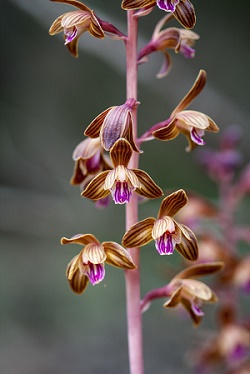
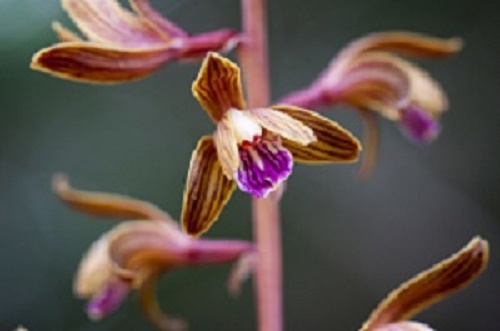
Hexalectris colemanii (Coleman's crested coralroot) is a terrestrial, myco-heterotrophic orchid lacking chlorophyll and subsisting entirely on nutrients obtained from mycorrhizal fungi in the soil. It is a very rare species endemic to southern Arizona, known from only three counties (Pima, Cochise and Santa Cruz). It is closely related to H. revoluta and the two are sometimes considered varieties of the same species.
Thelymitra jonesii


Thelymitra jonesii, commonly called the skyblue sun orchid, is a species of orchid that is endemic to Tasmania. It has a single erect, fleshy, linear, dark green leaf and up to six relatively small light blue to azure blue flowers with darker veins. It is a rare orchid known from only four scattered locations in moist coastal heath.
Thelymitra jonesii is a glaucous, tuberous, perennial herb with a single erect, fleshy, channelled, grass-like linear leaf 60210 mm (28 in) long and 3 6 mm (0.10.2 in) wide with a purplish base. Up to six light blue to azure blue flowers with darker veins, 1327 mm (0.51 in) wide are arranged on a flowering stem 80400 mm (320 in) tall. The sepals and petals are 613 mm (0.20.5 in) long and 28 mm (0.080.3 in) wide. The column is blue to purplish, 35 mm (0.10.2 in) long and 1.52.5 mm (0.060.1 in) wide with flanges on the side. The lobe on the top of the anther is blackish with a yellow fleshy, toothed tip and the side lobes have mop-like tufts of white or purplish hairs. The flowers are insect pollinated and open on warm days. Flowering occurs from September to December and flowering is more prolific after fire the previous summer.
Dendrobium taurinum


Dendrobium taurinum, the bull orchid, is a species of flowering plant in the Orchidaceae family. It is found in the Philippines and in the Indonesian Province of Maluku.[1][2] The size of the flower ranges from 5 to 6.5 cm.
Black orchid

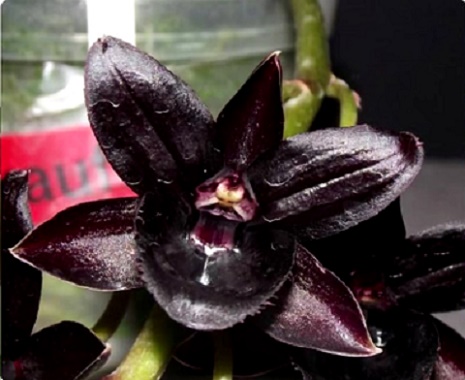
Arachnis flos-aeris, in particular the insignis variety. A species of orchid native to Southeast Asia.
Any member of several species of genus Bulbophyllum commonly called "Black orchid"
Brasiliorchis schunkeana, formerly known as Maxillaria schunkeana. A species of orchid native to Brazil
Calanthe triplicata, the Australian Black orchid
Catasetum tenebrosum, a species of orchid native to northern South America
Coelogyne fonstenebrarum (Fountain of darkness coelogyne), a species of orchid native to Borneo
Coelogyne mayeriana, a species of orchid native to Southeast Asia
Coelogyne pandurata (Black orchid), a species of orchid native to Borneo
Coelogyne ovalis, a species of orchid native to Indochina. Some cultivars have black-marked lips
Coelogyne usitana, a species of orchid native to the Philippines. The very dark lip can sometimes be described as being black
Coelogyne xyrekes, a species of orchid native to Southeast Asia
Corybas himalaicus, a species of orchid native to the eastern Himalayas, Assam, and Taiwan
Corybas pictus, a species of orchid native to Malaysia and Indonesia
Cymbidiella falcigera (Black orchid), a species of orchid native to Madagascar and Île aux Nattes
Cymbidiella humblotii (Black orchid), another Madagascar orchid species
Cymbidium canaliculatum (Queensland black orchid), a species of orchid native to northern and eastern Australia
Dendrobium canaliculatum var nigrescens, a species of orchid from Australia
Dendrobium convolutum, a species of orchid from New Guinea
Dendrobium hemimelanoglossum, a species of orchid native to Vietnam
Dendrobium johannis var nigrescens, a species of orchid from Australia
Disa cornuta, a species of orchid from South Africa
Dracula anthracina (the coal-black Dracula), a species of orchid from Colombia
Dracula benedictii, a species of orchid from Colombia
Dracula fuligifera, a species of orchid from Ecuador
Dracula minax, a species of orchid from Colombia
Dracula pholeodytes, a species of orchid from Colombia
Dracula roezlii, a species of orchid from Colombia
Dracula ubangina, a species of orchid from Ecuador
Dracula vampira, a species of orchid found on the slopes of Mount Pichincha in Ecuador
Dracula vlad-tepes, a species of orchid from Colombia
Epidendrum melanoporphyreum, a species of orchid from Peru
Fredclarkeara (Truly black orchid), a hybrid genus consisting of the genera Catasetum, Clowesia, and Mormodes
Gastrodia cunninghamii, a species of orchid from New Zealand
Grammatophyllum wallisii, a species of orchid from the Philippines
Haraella retrocalla, a species of orchid from Taiwan
Liparis nervosa (koku-ran コクラン, 黒蘭, "Black orchid'), a species of orchid native to Japan and China
Masdevallia picea, a species of orchid from Peru
Masdevallia rolfeana (Black orchid), a species of orchid native to Central America
Maxillaria variabilis a species of orchid native to Central America. Some cultivars (i.e. 'Black Eyed Susan') have black flowers
Monnierara (Black orchid), a hybrid genus consisting of the genera Catasetum, Cycnoches, and Mormodes
Ophrys incubacea, a species of orchid from the Mediterranean
Ophrys insectifera, a species of orchid from Europe
Paphiopedilum; Several species and hybrids in this genus of slipper orchids have black or near-black flowers, in particular Paphiopedilum adductum, Paphiopedilum bellatulum, Paphiopedilum boxallii, Paphiopedilum leucochilum, and the vinicolor forms of species in the Sigmatosepalum subgenus
Phalaenopsis mannii, a species of orchid native to Nepal and China
Prosthechea cochleata (Black orchid), the national flower of Belize that is also known as the Clamshell (or Cockleshell) orchid
Stanhopea nigroviolacea, a species of orchid from Mexico. Also known as Stanhopea tigrina var. nigroviolacea
Stelis immersa (Black orchid), also known as Pleurothallis immersa or Specklinia immersa. A species of orchid ranging from Mexico to Venezuela
Telipogon falcatus, a species of orchid from Colombia
Trichoglottis atropurpurea (Black orchid), a species of orchid native to the Philippines. Also known as Trichoglottis brachiata or Trichoglottis philippinensis var. brachiata
Tolumnia henekenii (Bee orchid), formerly known as Oncidium henekenii. A species of orchid from Hispaniola
thank you

Create Date :20 กันยายน 2561
Last Update :20 กันยายน 2561 23:11:34 น.
Counter : 1137 Pageviews.
Comments :0
- Comment
